I Played Every Single Tomb Raider Game, So You Don’t Have To – Part 3

The year is now 2023, and in an attempt to remain fresh, modern, relevant and topical: I’m going to start it off by reminiscing about a trilogy of games that started all the way back in 2006! I refer, of course, to the Legends trilogy of Tomb Raider games — featuring Tomb Raider: Legend itself, the Tomb Raider: Anniversary prequel-meets-remake, and Tomb Raider: Underworld, a game that punctuated the end of an era for Lara Croft fans everywhere.
We’ve already spoken at length about Lara’s past exploits throughout the Tomb Raider franchise, but here’s a brief recap to get you up to speed. In part 1, (which can be read here), we examined the original trilogy of Tomb Raider adventures, where each one proved to be better than the last — establishing Core Design as a significant name in the fifth generation of consoles.
It all started with the search for the Scion of Atlantis in TR1, continued through the hunt for the Dagger of Xian in TR2, and reached a climax in TR3, as Lara raced against the RX Tech company to find several pieces of an ancient meteorite; Rumoured to be magical in nature. These classic adventures redefined gaming in regards to both 3D graphics and exploratory environments, solidifying their place in the hearts of gamers everywhere!
Later on, (in part 2, which can be read about here), we observed the roller-coaster of the second trilogy. TR4 saw a distinct lapse in quality as Lara fended off against her possessed former mentor, hoping to prevent the resurrection of the Egyptian God Set. TR5, however, took us to new heights in quality, as its anthology framework told several unique stories regarding the Philosopher’s Stone, the Spear of Destiny, an ancient demon, and the Iris artefact. Yet TR6: Angel of Darkness managed to shoot itself in the foot, offering one of the most disappointing and unfinished sequels in the history of gaming…
With that, Eidos Interactive took the Tomb Raider franchise away from Core Design, passing the license over to Crystal Dynamics instead. These bright and shining newcomers had already made a name for themselves with their smash-hit Legacy of Kain series, but many still questioned where they could take the Tomb Raider franchise from here? What new adventures would Lara Croft be enduring at their behest, exactly?
Well, there’s only one way to find out…
Tomb Raider: Legend (2006)
Time Played: 4 hours, 29 minutes
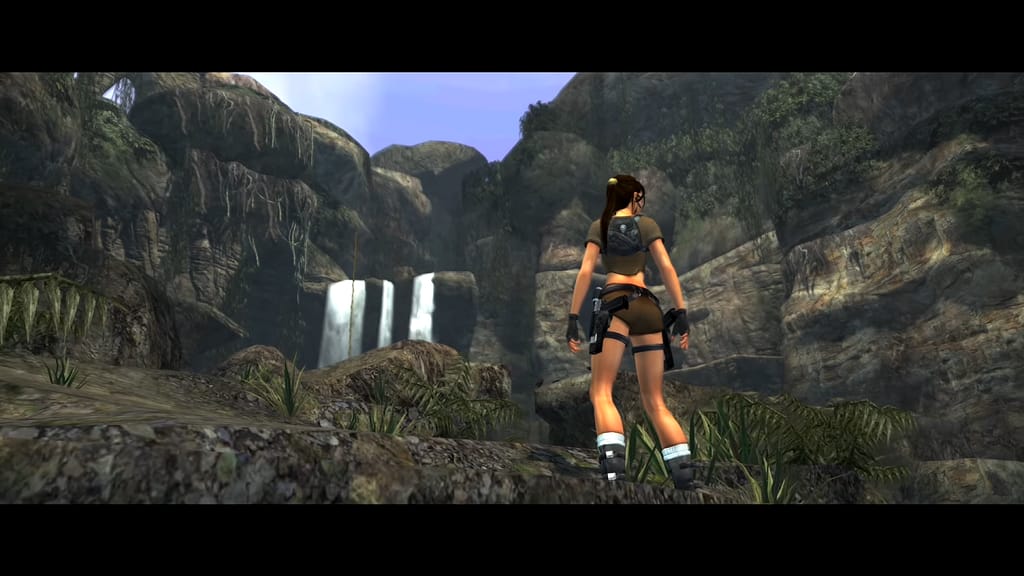
Put simply, Tomb Raider: Legend gave the series the highly requested and much-needed makeover that it deserved. Built upon a vastly upgraded version of the engine used for Legacy of Kain: Defiance, everything about Tomb Raider was about to change. The art style, the gameplay, the story, and even Lara Croft herself… Crystal Dynamics were eager to shake things up and point the franchise in a radical new direction.
Accomplishing this meant putting as much distance between Angel of Darkness and Crystal Dynamics’ shiny new reboot as they possibly could. Thus, a bold idea was proposed — Tomb Raider: Legend would still portray Lara as a seasoned treasure hunter and well-established archaeologist, but the game itself would otherwise be a completely fresh start for the series.
In other words: Legends would feature a brand new storyline that held absolutely zero ties to the original hexalogy… Past adventures would not be referenced; prior characters would either disappear or receive complete reinventions, and a new origin story would be created to provide Lara with more developed and understandable motivations.
In this timeline, Lara Croft became a treasure hunter for two reasons; To follow in her father’s footsteps and to search for her mother, who mysteriously disappeared some twenty years earlier in the vast mountains of Nepal. This vanishing act serves as the core framework to Legend’s new story, which takes Lara on a fast-paced global adventure that frequently crosses paths with the mythos of King Arthur and his sword Excalibur. From Bolivia to England, with detours to Japan, Kazakhstan, and Ghana, the mystery never stops growing, dripping with charm and intrigue at every single turn.
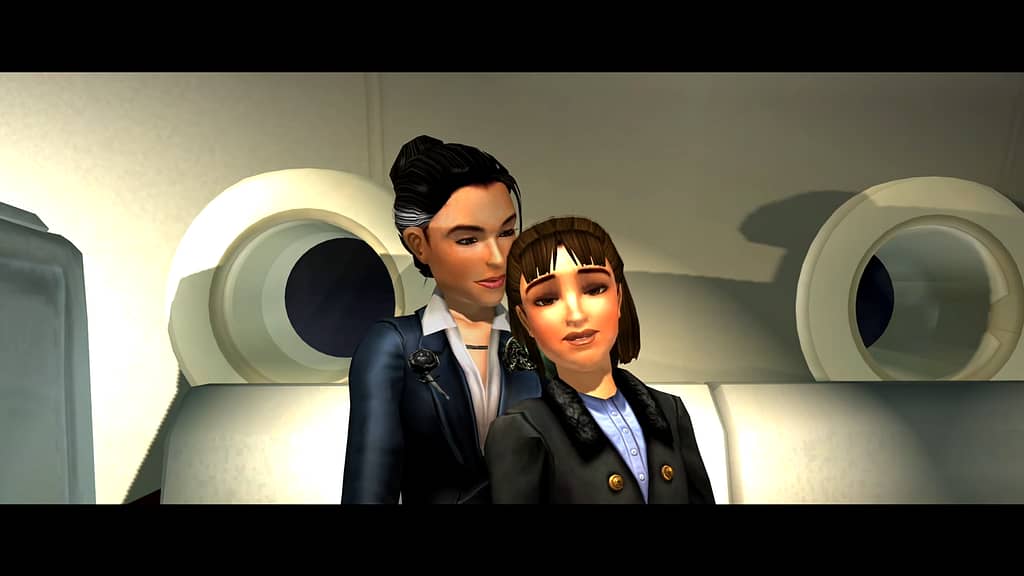
Miss Croft herself feels equally well realised within this fresh portrayal. She’s bold and talented —of course— but far less calm and collected than ever before. The disappearance of her mother is a deeply personal impetus, after all, and sets her on a much darker and more aggressive path as her journey progresses. Thankfully she’s not all doom and gloom, though, as she often speaks playfully and optimistically with her butler Winston, alongside two new side-kicks who she communicates with via a comms system.
These are research assistant and history buff Alistair Fletcher, and tech expert Zip, who made a brief appearance in Tomb Raider V: Chronicles to help Lara infiltrate Von Croy Industries. This representation of Zip is far less stereotypical and two-dimensional than his Core Design counterpart, however, and has a good back and forth with both Alistair and Lara, providing some light-hearted commentary throughout the trials and tribulations of each level.
Whilst Lara has interacted with plenty of other characters within the original series, the vast majority of those conversations were either extremely fleeting or shockingly robotic in regards to Angel of Darkness… As such, the back and forth seen here —alongside further authentic interactions with several other characters, such as close friends Toru and Anaya, or enemies Amanda and James— make a huge difference to the believability of each person, causing you to care far more about them and their relationships.
All in all, it’s a great story, if a little on the short side. The usual trappings of a Tomb Raider title are all present here, but Legend’s fast pacing often prevents it from having the same narrative scope as the older games. The storytelling here is the absolute best that the series has offered so far, and you will enjoy its globe-hopping progression; But when each area is visited so briefly —with its plot developments primarily coming at the beginning and end of each locale— it never quite manages to feel like the grand-scale adventure that a fan will have come to expect.
Thankfully, this shortcoming is balanced out somewhat by the impressive new control scheme. Gone are the days of stiff tank controls and grid-based platforming, as Legend finally introduces free movement to the franchise. Essentially, this means that instead of Lara moving forwards in whichever direction she’s facing (with you having to rotate her entire body to change direction); Players can now get her to move and jump whichever way they point the analog stick without needing to rotate her at all.

I’ve always been a fan of tank controls in games, but there are some genres where it works far better than others. These rigid controls perfectly compliment classic survival horror games like Resident Evil and Silent Hill, for example, as the often claustrophobic rooms you find yourself in are designed to feel restrictive — with tank controls elevating the tension that they create. Games with platforming mechanics, on the other hand, need to feel freeing, and whilst I do love how the original Tomb Raider games felt: By 2002’s Angel of Darkness, they were lagging desperately behind when compared with the free movement systems that other platformers had been offering for years.
Legend’s movement system still feels smooth to this very day. Whether you’re running from point A to point B, swinging from ropes or horizontal bars, flipping and rolling your way through combat encounters, or even using the brand-new grappling hook mechanic: You will never feel dissatisfied. This movement feels purpose-built for the environments you traverse — carefully handcrafted to ensure that parkour always feels good, always looks masterful, yet never feels overly complicated.
Speaking of combat encounters, Legend drastically changes the way they function. The Tomb Raider series has always struggled somewhat when it comes to combat, primarily due to the selection of weapons being changed from game to game, without anything new being offered in regard to core fighting mechanics. This time around, though, there’s plenty of new content on offer.
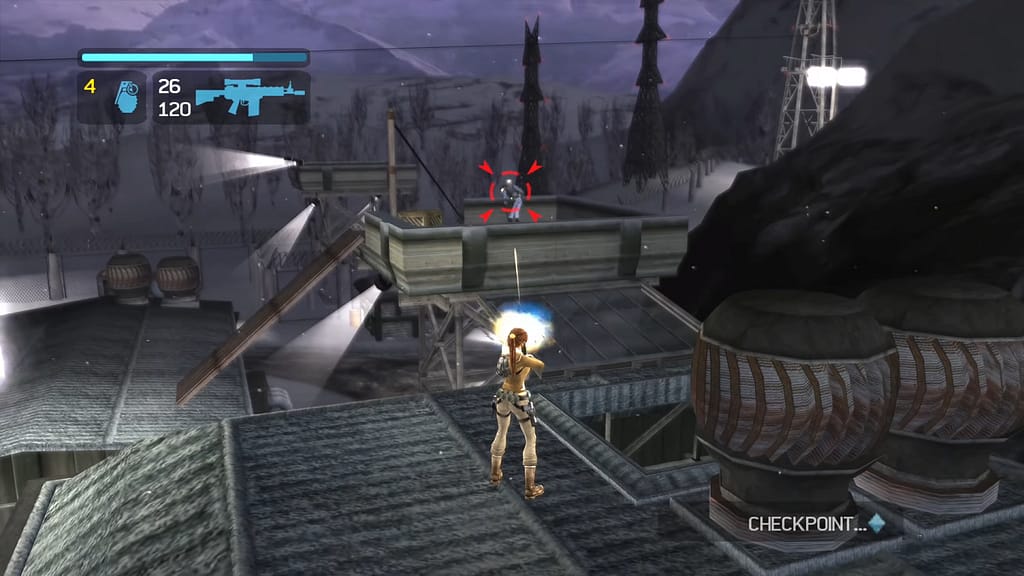
Lara’s signature dual pistols have returned after their strange absence from Angel of Darkness, and they’re thankfully accompanied by plenty of other nostalgic TR guns. An assault rifle, a shotgun, an SMG, and a grenade launcher are all available here, alongside a new plot-relevant weapon that I can’t bring myself to spoil! It’s a pleasing arsenal of familiar Tomb Raider weaponry, only hindered by the introduction of the “primary and secondary” gun system that Call of Duty had popularised not long beforehand.
With this system in place, you always have your dual pistols equipped to your primary weapon slot but can only carry one extra gun with you at any given moment, having to swap it out for others as and when your enemies happen to drop them. It’s a restrictive concept that I’ve never been a huge fan of, but thanks to a couple of other combat additions, such as one-button grenades and environmental hazards that can be dropped on your enemies: It only ever presents as a minor nuisance, rather than a major obstacle.
Finally, vehicle sections are yet another wonderful returning feature, which hasn’t made an appearance since 1999’s TR4. This time around, they feel more akin to endless runner-game segments than the open-level traversal of prior entries. Within them, you’ll find yourself barrelling down linear paths, dodging obstacles at intense speeds, and contesting with several enemies, all of whom will stop at nothing to halt your progress! It really is an adrenaline-fuelled experience that is sure to get your heart racing!
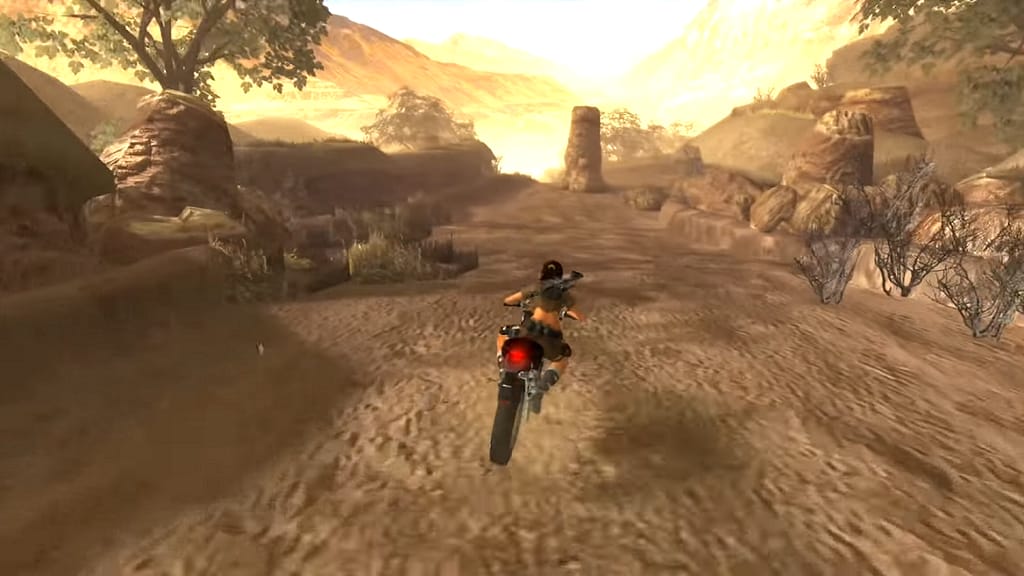
So, all in all, would I recommend Tomb Raider: Legend..?
Yes! Absolutely! For all of its faults between the short campaign, story-pacing issues and restrictive two-weapon system, the positives it has to offer are far more significant! The narrative is better than it has ever been before, the movement has been improved in countless notable ways, the gunplay is fulfilling and nostalgic, and the vehicle sections are quite unlike anything that Tomb Raider has featured in the past.
Legend is an excellent starting point for a new era of Lara Croft stories, showcasing exactly what Crystal Dynamics are capable of at each and every turn. It’s no surprise that a brand new trilogy was spawned by this title because it absolutely deserved a follow-up to expand upon its highly immersive narrative. As a result, I’d recommend Tomb Raider: Legend to both newcomers and die-hard fans alike, and I think you’ll be plentifully surprised by just how good it can be!
Tomb Raider: Legend – 8.5 / 10
Tomb Raider: Anniversary (2007)
Time Played: 8 hours, 11 minutes
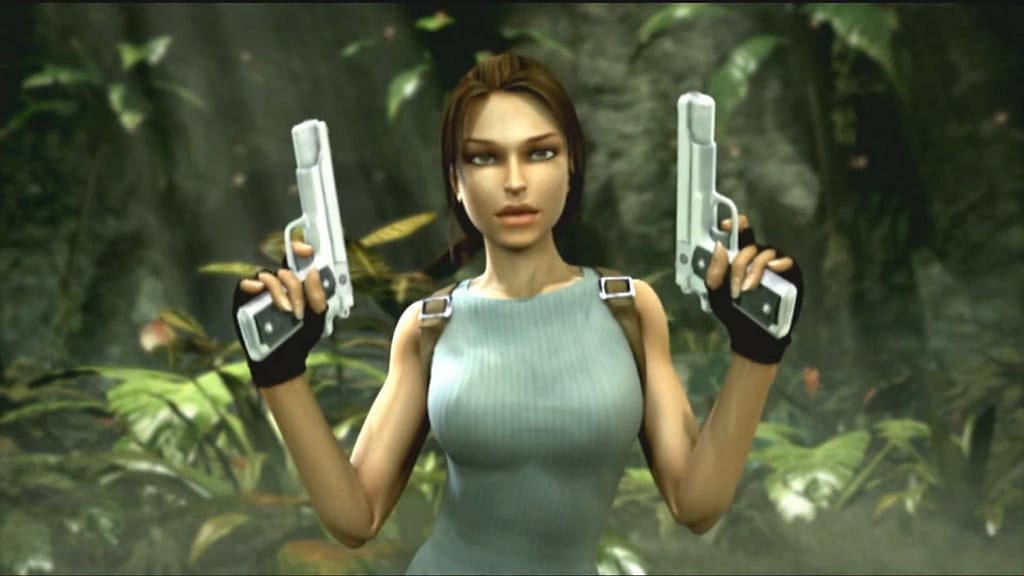
Following on from Tomb Raider: Legend is a very unusual experience indeed… Tomb Raider: Anniversary is not a typical successor because it isn’t just the second game in the Legends trilogy… It is also a remake of the first-ever game from 1996, albeit with some story beats retooled to make it function as a prequel to Legend — no longer connected to the alternate timeline of TR2 through to TR6.
Apparently, this was because Tomb Raider: Anniversary was something of a recovery project, attempting to salvage a then-canceled remake of the original game. Core Design had actually been working on this remake for the ten-year anniversary of the Tomb Raider series just before its license was taken away from them… Crystal Dynamics then revived the project and subsequently adapted it to continue the Legends storyline, hoping to tie in several of its plotlines with the upcoming conclusion of their trilogy.
As such, most of Anniversary’s core narrative feels largely familiar. Lara is still hired by Jacqueline Natla to find the Scion of Atlantis, and she still travels to Peru, Greece and Egypt to collect each of its parts. She once again clashes with Larson and Pierre Dupont, and she still goes on to defeat Natla —now revealed to be an Atlantean— before making a grand escape. The only substantial narrative difference in Anniversary is that several key scenes have been fleshed out further in order to mould this classic story into the aforementioned continuity of the Legends trilogy.
For example, there are a few new scenes and brief lines of dialogue regarding Lara’s father and his search for Lara’s mother, providing a smoother transition into the storyline of TR: Legend. I believe there’s also an extra line or two hinting towards the existence of Alistair and Zip, but Lara’s new interactions with each villain prove to be far more noteworthy additions!
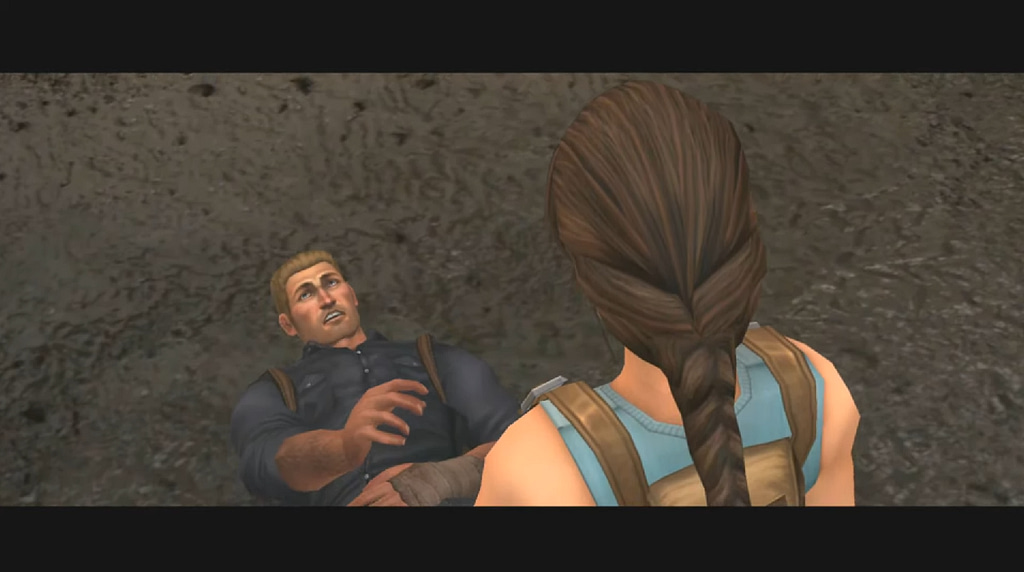
Anniversary puts forth the idea that Lara has never killed a person before; She’s slain plenty of monsters of course —and continues to do so here, just like in the original— but her lack of experience with outright murder leads to confrontations with each antagonist to feel far more significant to her character development. These new scenes disturb Lara and more thoroughly showcase how she became the more violent and hot-headed protagonist that caught fans off-guard back when TR: Legend first released.
They’re certainly neat additions! I personally can’t say that they add all that much to the original game’s story, given that each change is so minor and fleeting, but they certainly don’t detract from it either. Narratively speaking, Anniversary may not feel completely at home in the Legends trilogy, given how odd the “remake-meets-prequel” concept can be, but it does help everything flow a little better through the jarring transition from reboot to original series retcon.
Unfortunately, when it comes to gameplay: Anniversary can be a tad hit-and-miss. The excellent control scheme from TR: Legend does return here, bringing a brand-new combat mechanic with it. Lara is now capable of performing last-second dodges in order to briefly slow down time and pull off high-risk, high-reward counterattacks. It works reasonably well, though timing it correctly can be a little difficult to get used to at first.
Sadly, the first problem arises with Anniversary’s new platforming mechanic, which has a tendency to be rather inaccurate at times… Lara is now capable of hopping across the tops of columns and poles rather than exclusively clinging onto their sides. This caused me to die needlessly on a number of occasions, primarily due to some time-restricted sequences that required me to use this new mechanic at breakneck speeds.
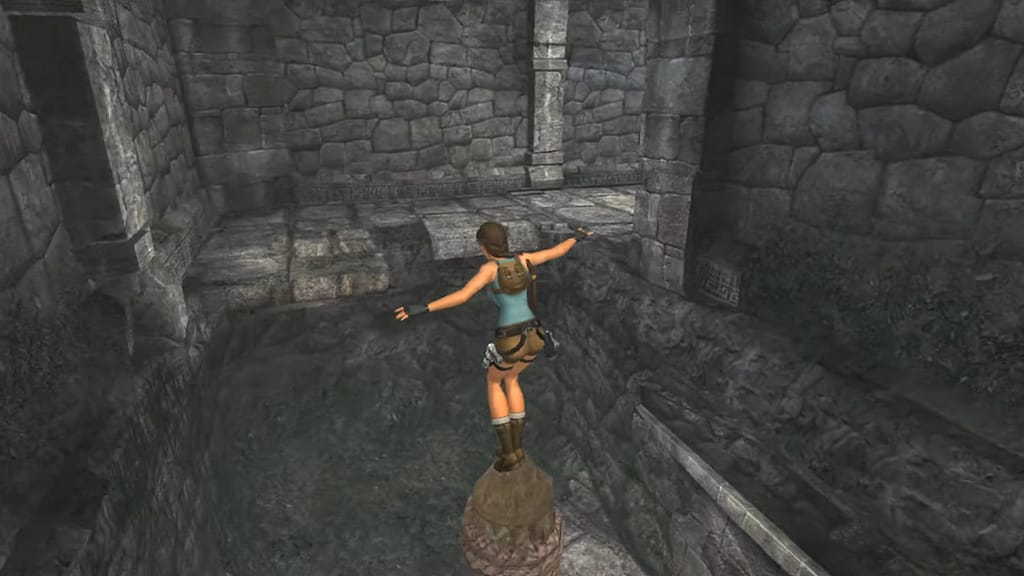
This is due to the way that Lara leaps from column to column. It sounds like a straightforward concept, yet each jump is accompanied by an unusual sense of gravity, pulling you from one column to the next without considering the player’s inputs, no matter how you attempt to direct Lara’s trajectory. I believe this is the game’s way of subtly trying to prevent you from falling, but it can be so disorientating during these fast-paced timed sections that it often has the inverse effect — dragging Lara away from where you’re directing her and frequently causing her to plummet to her death…
There are a number of classic mechanics reintroduced here that do counter this lapse in platforming quality. Health no longer automatically regenerates, meaning you’ll need to find medkits to endure each level, just like in the good old days. Each of the original game’s weapons also returns here —the signature dual pistols, a shotgun, a pair of magnums, and a pair of SMGs— which can be equipped very quickly thanks to the convenience of the D-Pad, and can all be carried at the same time. Yet as I said: The game can be quite hit and miss, meaning that a second major issue in the form of Anniversary’s lacklustre boss fights, often prevents these positives from really standing out…
There was something very magical and intense about taking on the T-Rex near the start of Tomb Raider 1996. It made you feel genuinely scared and intimidated, resulting in a frantic sprint around a highly detailed valley in search of a safe hidey-hole to fight it from. Here in the remake, however, the fight takes place in a large empty arena with zero locations to hide — the experience is immediately interrupted by a large tutorial pop-up regarding a “rage” mechanic you must utilize in order to deplete its colossal, bullet-sponge health bar. The fight then concludes with a big Quick Time Event (QTE) to finish it off, as was the style at the time.
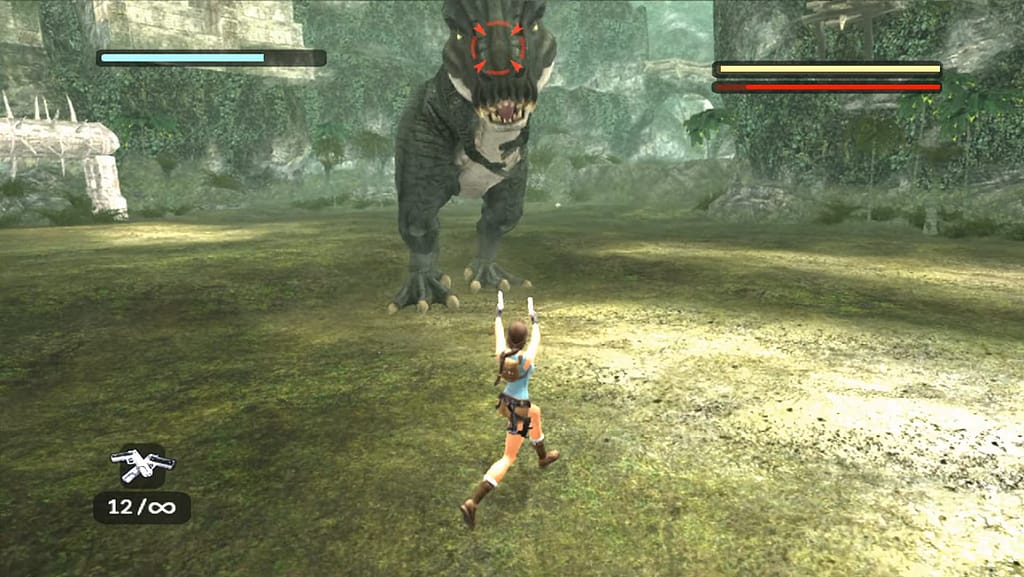
This completely sucks all of the tension out of the encounter, causing it to feel formulaic, generic, and totally devoid of charisma. This isn’t just true of the T-Rex either, as each of the three penultimate boss fights are handled in very similar ways. The original game offered fully realised fights with each one, featuring entire level sections that were dedicated to fighting them across tricky boss-specific environments. Here in Anniversary, however, they’re all introduced and defeated within a series of QTE cutscenes, and that’s all there is to them… It’s a really disappointing experience that definitely fails to live up to the original or stand on its own two legs.
As such, I don’t feel all that strongly about Tomb Raider: Anniversary… It’s not that I think it’s a terrible game or that I’d recommend against playing it; Particularly due to the relevance of its new story-beats when experiencing the Legends trilogy on the whole. But I would certainly recommend the original over it at any given opportunity, which in and of itself means that Anniversary has failed to serve its purpose as a remake…
Tomb Raider: Anniversary – 5.2 / 10
Tomb Raider: Underworld (2008)
Time Played: 7 hours, 22 minutes
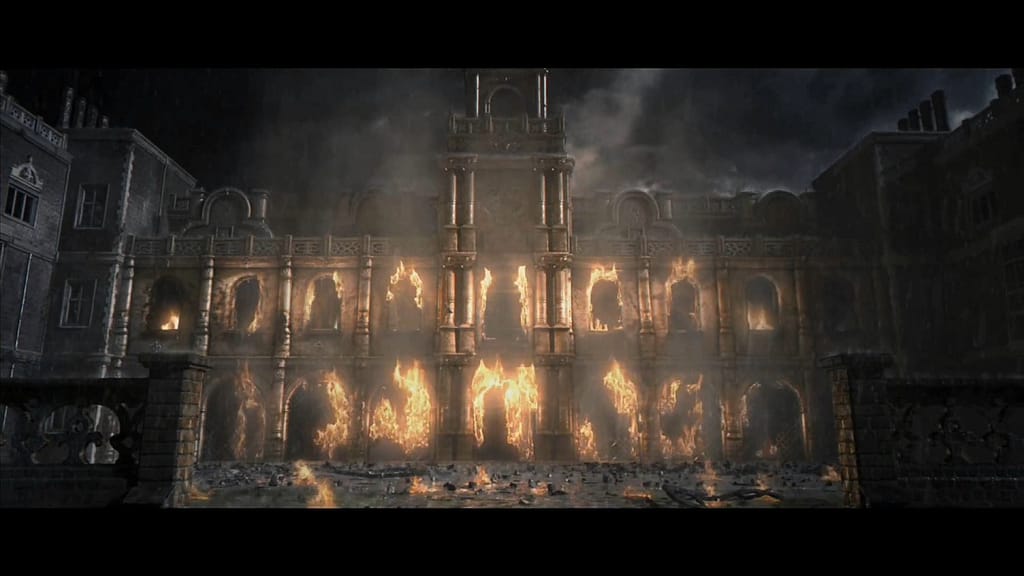
With Legend and Anniversary now out of the way, we’ve found ourselves at ~the end~, or at least an end, with Tomb Raider: Underworld — the exciting conclusion to the Legends trilogy. Underworld begins with a high-octane cold-open which hits closer to home than ever before, as a sudden explosion tears through Croft Manor, totally engulfing it in flames.
Lara —unfortunately caught just beneath the epicentre of the blast— works her way up through the burning, rubble-filled corridors of her home, attempting to reach her friends. Upon entering the main hall, however, she finds herself being unexpectedly shot at by Zip in a shocking, contextless, and cinematic turn of events that perfectly sets the tone for the serious, jaw-dropping journey to come.
Who caused the explosion? Why would Zip shoot at Lara? Why did any of this happen? To answer all these questions and more, we’ll have to flash back to one week prior, as Croft begins her search for the mythical island of Avalon, deep within the Mediterranean Sea. Though the majority of her questions regarding the disappearance of her mother were already answered in TR: Legend, Lara is still not satisfied, and feels certain that diving into the heart of Norse mythology will provide her with the truths she seeks.
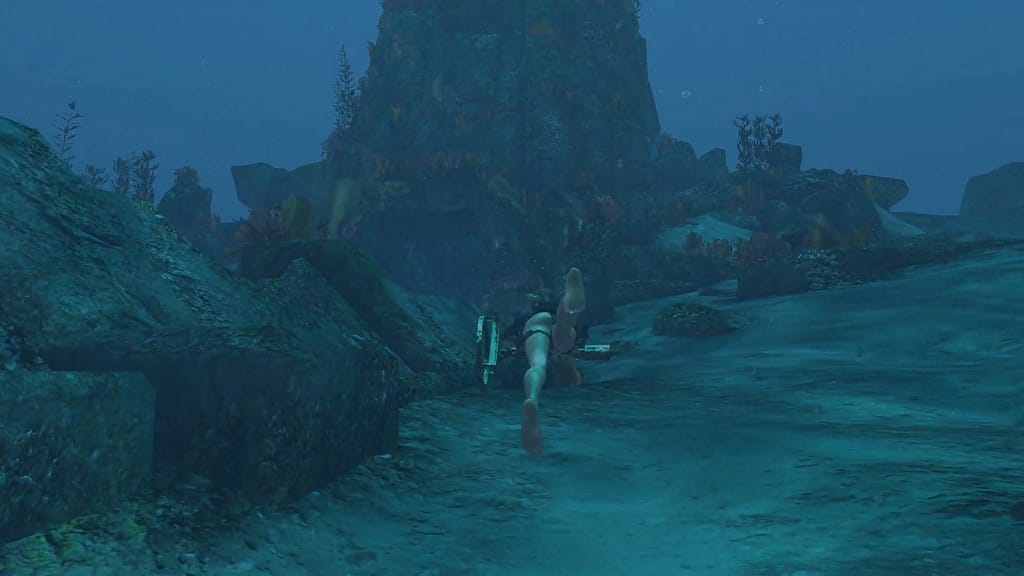
This serves as the starting point for another globe-trotting adventure through several beautifully rendered locales, such as Thailand, Mexico, and Norway. It’s an excellent conclusion to the story that features plenty of callbacks, making Legend and Anniversary feel far more meaningful in retrospect. I really can’t stress enough just how well Underworld has aged, too, demonstrating gorgeous graphics that still hold up against the visuals of several modern AAA titles. Yet, it feels like there’s something missing within its narrative structure…
Because there is.
Tomb Raider: Underworld is a good conclusion to the trilogy and a complete product in its own right, yet by the end-point: There are a couple of loose ends that you can’t help feeling bothered by… These primarily revolve around the existence of a certain mysterious antagonist, whose origins and downfall remain largely unexplained throughout the course of the campaign. I won’t be spoiling the finer details here, but I must say that whilst the main story does feel fulfilling, the circumstances surrounding this particular side-antagonist feel rather rushed by comparison.
This is because Tomb Raider: Underworld received two DLC episodes throughout 2009, which expand upon this particular character and serve as a more definitive epilogue to the story, tying up these few loose ends in the process. So, why is that a problem, exactly? Well, sadly, these DLCs were never released for the PC version of the game, which was the only platform I was able to play it on…
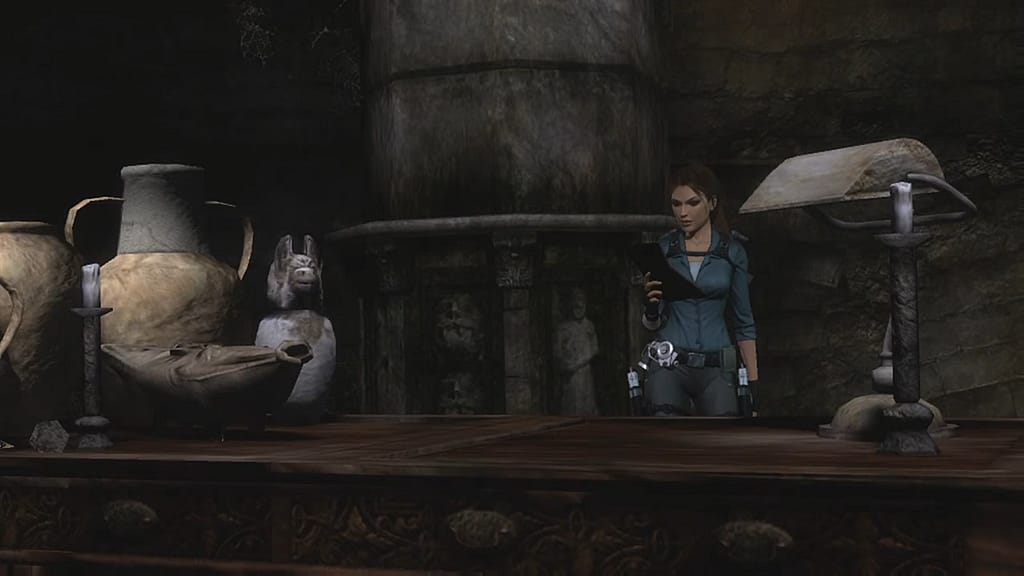
Whilst I have read up on their contents since, both the “Beneath the Ashes” and “Lara’s Shadow” expansions were only released for the Xbox 360 version of the game, leaving the PC and PS3 iterations forever doomed to be partially incomplete. To my knowledge, these DLCs were technically re-released for the Xbox One version of the title, but as a gamer who hasn’t owned a Microsoft console for several generations in a row now: I can’t help feeling let down by this… Underworld itself is narratively stellar, yet I will never be able to experience it in its entirety due to this thoughtless instance of DLC exclusivity. So to say it’s disheartening would be quite an understatement indeed.
On the plus side, Underworld’s consistently enjoyable gameplay does a lot to assuage this disappointment. Not all that much is added in terms of movement this time around besides the ability to balance on certain thin beams and the introduction of climbable rock walls that blend naturally into the environment. Yet this Tomb Raider title is easily the most polished rendition of the formula that we’ve talked about so far, feeling rewarding and enjoyable no matter what actions you may perform.
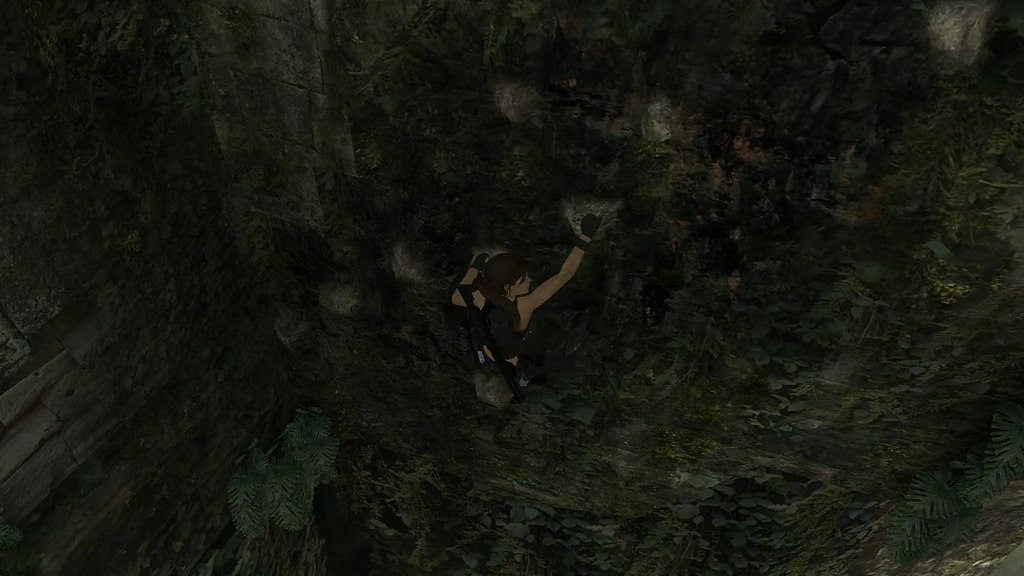
Immersion plays a big role in this. One of Crystal Dynamics’ central goals for Underworld was to make each animation look as natural as possible. To that end, Lara now leaves footprints behind as she traverses through dirt and uses her hands to brush foliage aside and balance herself when walking close to walls. She’ll slip more regularly on wet surfaces; The bodies of her enemies never despawn, and anything she damages will result in debris affected by physics rather than scripted animations.
It all comes together to create a thriving world that feels genuinely mesmerising to explore. Honestly, it’s quite refreshing to see such a large amount of focus placed on the overall immersion rather than prioritising the implementation of a few minor mechanics instead — as the series has been known to do since it first began. That’s not to say that there are no new mechanics, however; Combat in Underworld has seen numerous evolutions in the year since Anniversary and offers several brand new features from the very start of the game.
For example, Lara is now capable of shooting any one-handed weapon whilst she climbs, creating entirely new ways to take on airborne enemies. She can also make full use of the dual pistols when fighting on the ground by locking on to one enemy whilst aiming at another, therefore taking out two separate opponents at the exact same time! Plus, if an enemy gets too close, you can always fall back on the quick and versatile melee system, which you can use with the push of a single button.
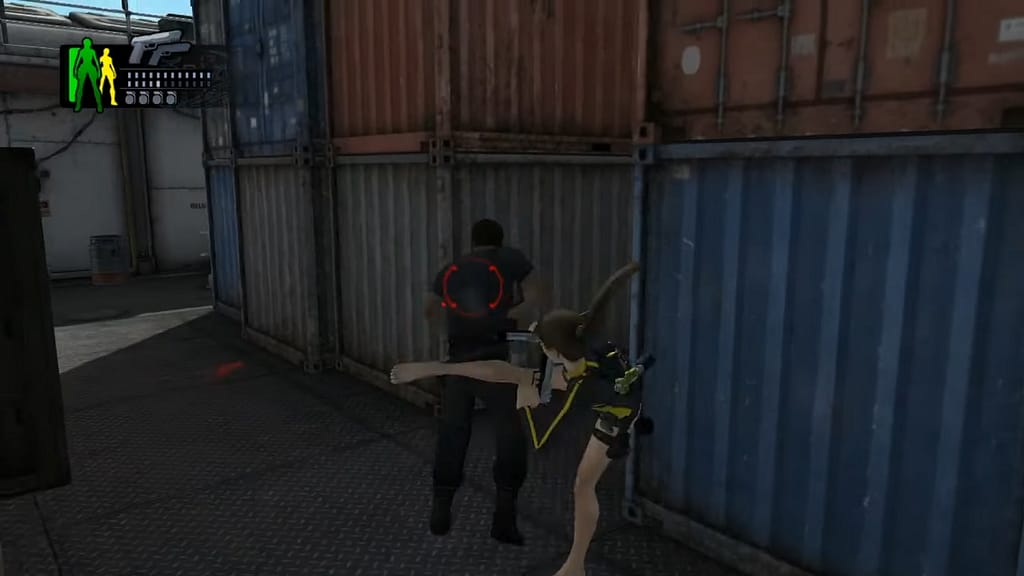
There aren’t many new weapons on offer here, as Underworld features a near identical arsenal to TR: Legend — albeit with the introduction of a spear gun (for underwater combat) and a tranquillizer gun (to avoid killing animals), which have collectively replaced Legend’s grenade launcher. Thankfully though, this escapade is greatly improved by allowing you to equip any weapon you want at any given time through the use of a loadout system on Lara’s PDA. It’s very pleasing to have access to the full armoury from second one this time around and it solidifies Underworld’s combat as a thing to be enjoyed rather than a challenge to overcome.
With the exception of a few strangely open hub areas in Angel of Darkness, the level design of the Tomb Raider series hasn’t changed all that much since TR5, meaning I haven’t needed to bring it up for quite some time… That changes now, though, as I must direct a whole heap of praise toward Underworld’s unique take on puzzles, which span across entire levels and feel like faithful adaptations of the original trilogy’s open-space design philosophy. They’re never too confusing as they offer just enough hints to help you on your way, yet each area is large enough to feel fresh and gripping in a completely different style to the rest of the Legends trilogy.
With that, the only thing left to mention is the reintroduction of open-world vehicle sections by way of Lara’s motorcycle. These sections are brief, only appear on two levels, and usually just serve as a method of traversing from one area to the next. Besides a small number of dedicated tracks that separate the larger of the two levels into smaller zones, these areas can be explored exclusively on foot, so the bike serves as a tool of convenience more than anything else. I’d say it’s nowhere near as exciting as the runner-game sections of TR: Legend as a result, but it’s not bad either — just surprisingly passive when compared with prior entries.
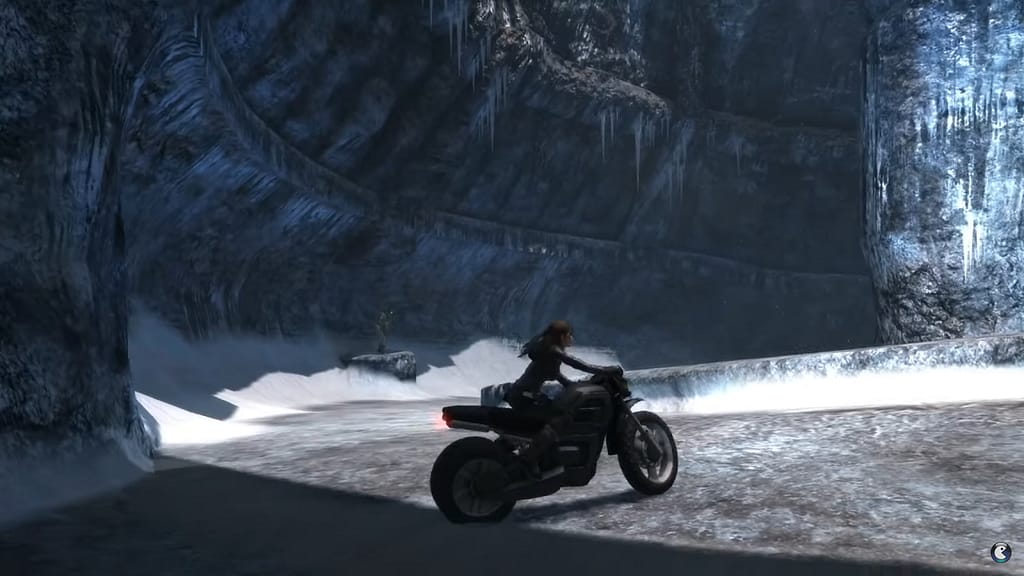
But where does all that leave us? Well…
Tomb Raider: Underworld is a superb adventure, reaching countless dizzying highs without ever falling beneath a good baseline quality level. Its narrative is satisfying with a plentiful amount of pay-off, its combat prioritises fun over complexity, its immersion factor takes the series in an enthralling direction that it hasn’t truly touched upon before, and its level design feels like a genuine evolution from the original concept, rather than a continuation of the linear design found in the rest of the Legends trilogy.
Yet, with its DLC lacking any form of accessibility for players without an Xbox console: I always have to offer a warning alongside my recommendation, which isn’t exactly ideal… Nevertheless: I do recommend it —and strongly so at that— as it pairs perfectly with TR: Legend, whether you enjoyed Anniversary or not. I’ll always have a personal preference towards Legend due to the nostalgia it holds for me personally, but objectively speaking: Underworld is the better game in every way that matters.
Tomb Raider: Underworld – 8.7 / 10
Conclusion

Sadly, this brings us to the end of the Legends trilogy, though Crystal Dynamics were far from finished with the series on the whole! It’s safe to say that despite the slight lapse in quality that Anniversary was responsible for, these new developers had more than proved their worth to the Tomb Raider fanbase. Yet, with Underworld bringing the current storyline to a close, people were quick to question where Lara could possibly go from here?
Worry did sink in for a time, as there wouldn’t be another mainline update to the franchise for several more years. There was a significant spin-off release in 2010 by way of ‘Lara Croft and the Guardian of Light’, (more on that later), but with no movies, books, shows or core releases to speak of: Fans were eager to get their hands on just about anything new.
Thankfully, 2013 would go on to become a huge turning point for the series, with a whole new reboot trilogy just over the horizon. But… That’s enough for now, I think. Be sure to keep yourselves prepared though, as part 4 will be coming out very soon and you’ll need your best survival instincts at the ready if you intend to endure it!
Until next time: Stay strong, fellow raiders!